GRAPH OF LINEAR EQUATION ax + by + c1 = 0
Coordinate Geometry of Class 9
Graph
ax + by + c1 = 0
Steps to draw linear equation graph.
Step 1. Arrange the terms to find the value of y in terms of x
i.e. y = mx + c form
where and
and 
Step 2. Assume three integer values of x, and get the corresponding values of y.
Step 3. Prepare a table for the ordered pairs (x, y).
Step 4. Plot these points on a graph paper by considering suitable scale.
Step5. Join these points to obtain the graph of the line ax + by + c1 = 0.
question Draw the graph of the line y = mx + c.
Solution: y = mx +c
∴ Required table is
|
x |
0 |
|
|
|
Y |
c |
0 |
2c |
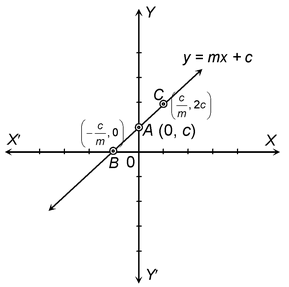
1. The graph of the line changes if the signs of m and c differ.
2. Here m (the coefficient of x) in the equation y = mx + c is known as slope of the line.
3. c is known as intercept on y-axis i.e., OA = c.
eg. Draw the graph of y= x +2
Step 1. Arrange the terms to find the value of y in terms of x
i.e. y = x +2 form
where m = 1 and c = 2
Step 2. Assume three integer values of x, and get the corresponding values of y.
Step 3. Prepare a table for the ordered pairs (x, y).
Step 4. Plot these points on a graph paper by considering suitable scale.
Step 5. Join these points to obtain the graph of the line ax + by + c1 = 0.
∴ Required table is
|
x |
0 |
-2 |
1 |
|
Y |
2 |
0 |
3 |
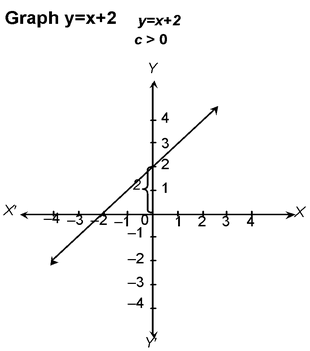
SECTION FORMULA :
A point P divides the straight line joining two points A(x1, y1) and B(x2, y2) internally in the ratio m1 : m2, to find the coordinates of P.
Let the coordinate of P be (x, y). AR, BT and PS perpendiculars have been drawn on the X-axis from A, B and P respectively. Now, AQ and PC perpendiculars have been drawn from A and C on PS and BT respectively. In figure.
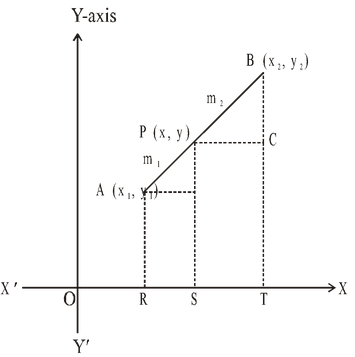
AQ = RS = OS – OR = x – x1,
PC = ST = OT – OS = x2 – x,
PQ = SP – SQ = SP – RA = y – y1, and
BC = TB – TC = TB – SP = y2 – y.
Now, from similar triangles APQ and PCB, we have,


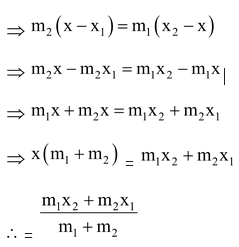
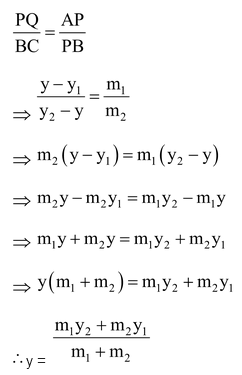
Hence, the coordinates of point P which divide the straight line joining two points (x1, y1) and (x2, y2) internally in the ratio m1 : m2 are,

Coordinates of the Mid-Point :
If P is the mid-point of AB, then it will divide AB in the ratio of 1 : 1, then coordinates of P are :

question. If the point C(–1, 2) divides internally the line segment joining A(2, 5) and B in ratio
3 : 4, find the coordinates of B.
Solution: Let the coordinates of B be in figure. It is given that AC : BC = 3 : 4. So, the coordinates of C are :
in figure. It is given that AC : BC = 3 : 4. So, the coordinates of C are :
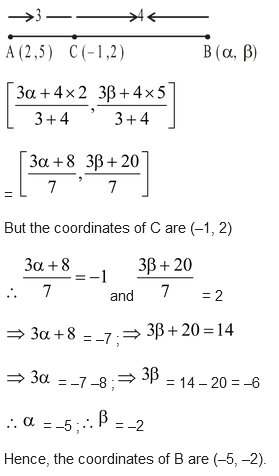
CENTROID:
The point of the intersection of the medians of a triangle is called centroid of a triangle.
Theorem :
Prove that the coordinates of the centroid of the triangle whose vertices are (x1, y1), (x2, y2) and (x3, y3) are
 .
.
Also, deduce that the medians of a triangle are concurrent.
Proof: Let A(x1 , y1) B(x2 , y2) and C(x3, y3) be the vertices of ΔABC whose medians are AD, BE and CF respectively. So, D, E and F are respectively the mid points of BC, CA and AB.
Coordinates of D are  .
.
Coordinates of a point dividing AD in the ratio 2 : 1 are
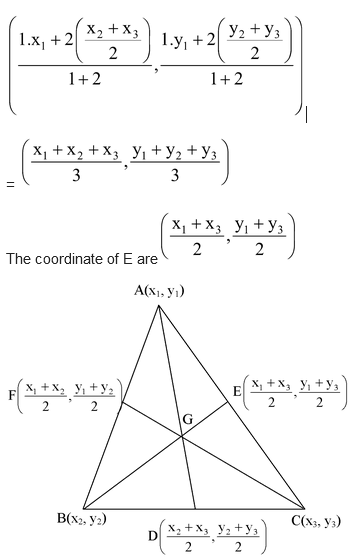
The coordinates of a point dividing BE in the ratio 2 : 1 are
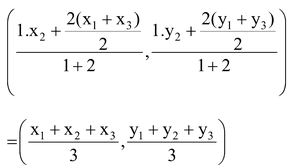
Similarly the coordinates of a point dividing CF in the ratio 2 : 1 are

Thus, the point having coordinates coordinate geometry  is common to AD, BE and CF and divides them in the ratio 1 : 2.
is common to AD, BE and CF and divides them in the ratio 1 : 2.
Hence, medians of a triangle are concurrent and the coorrinates of the centroid are  .
.
question. Find the coordinates of the centroid of a triangle whose vertices are (0, 6), (8, 12) and (8, 0).
Solution: We know that the coordinates of the centroid of a triangle whose angular points are (x1, y1) (x2, y2), (x3 , y3) are

So, the coordinates of the centroid of a triangle whose vertices are (0, 6), (8, 12) and (8, 0) are

AREA OF A TRIANGLE:
We have already studied in previous classes about how to calculate the area of a triangle when its base and corresponding height altitude are given.
We have used the formula :
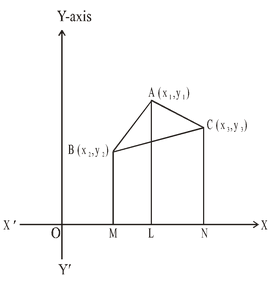
Area of triangle 
Besides this, we have also studied in previous class about how to find the area of a triangle by using “Heron’s Formula”, When the length of the sides are given.
i.e., Area of a triangle
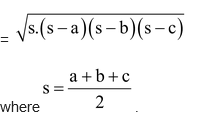 .
.
Let A(x1, y1), B(x2, y2) and C(x3, y3) be the vertices of  . AL , BM and CN perpendiculars have been drawn from A, B, C to the X-axis.
. AL , BM and CN perpendiculars have been drawn from A, B, C to the X-axis.
Area of  = Area of trapezium ABML + Area of trapezium ALNC – Area of trapezium BMNC
= Area of trapezium ABML + Area of trapezium ALNC – Area of trapezium BMNC
We know that :
The area of a trapezium
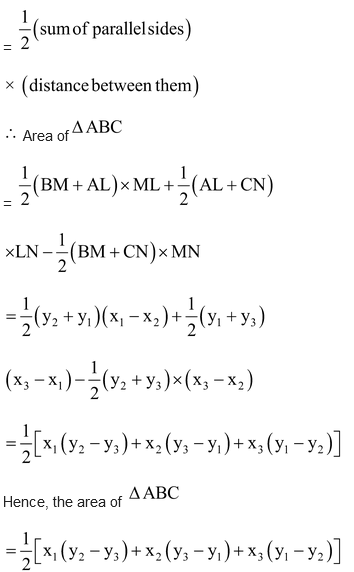
question. Find the area of the triangle formed by the points A(5, 2), B(4, 7) and C(7, –4).
Solution: Here, x1 = 5, y1 = 2, x2 = 4, y2 = 7, x3 = 7 and y3 = –4.
∴Area of 
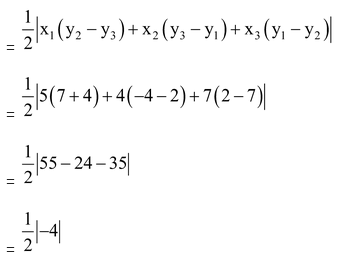
Hence, area of  = 2 sq.units.
= 2 sq.units.
question. Prove that the point (-2, -1), (-1, 1), (5, -2) and (4, -4) are the vertices of a rectangle.
Solution: Let P(-2, -1), Q(-1, 1), R(5, -2) and S(4, -4) be the given points
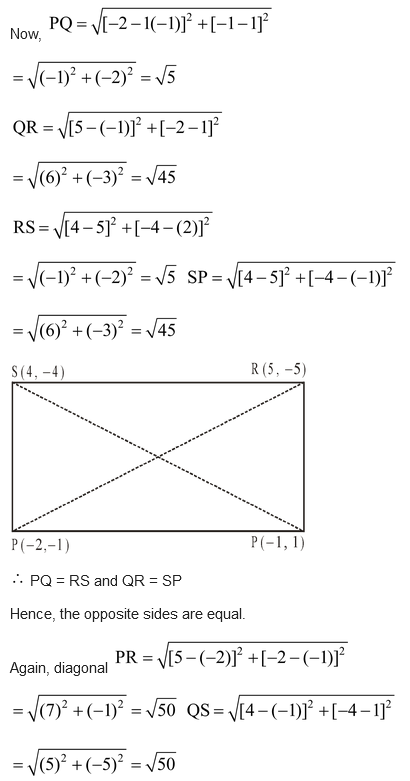
Hence the diagonals are equal.
Hence the given point P, Q, R, S are the vertices of rectangle.











